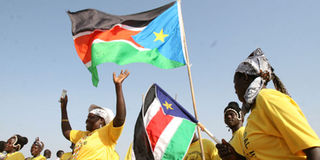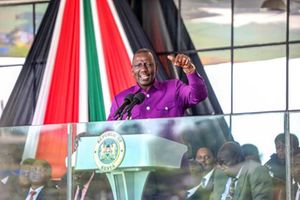Land issue: A short-fused time bomb

Madi traditional dancers during the referendum at Dr John Garang Mousoleum in Juba, Southern Sudan, January 9, 2011. PHOTO/STEPHEN MUDIARI
Land will be the most important production factor that foreign investors will be looking at before committing their resources to Africa’s newest country.
This is because agriculture will be the big thing in South Sudan, overshadowing oil and minerals. Agricultural experts say that South Sudan, with its vast, arable virgin land, is be capable of feeding the entire East African region.
But then the question is, what land laws are in place and are they friendly to foreign investors? The new Land Act, 2009, which is currently ongoing improvement, is the law under which foreign investors will be looking at before investing in the country.
According to the law, land belongs to the community; thus only locals are allowed to buy land. Foreign investors can only lease land for a maximum of 99 years. If a local is selling land to a foreigner, then he/she must notify the authorities so that it is turned into a lease.
Locals can sub-lease to investors for any number of years provided it does not exceed the 99-year ceiling. In the rural areas, the community collectively owns the land and any local who intends to lease to an investor must get permission from the local leaders. Still, even with permission, a foreign investor can only acquire a maximum of two acres. Anything more than that has to go through Parliament of the given State and the State governor.
According to Robert Ladu Luki, chairperson of the South Sudan Land Commission, there has never been a comprehensive land policy for the entire Sudan since the colonial time.
All the land policies during the British rule: The 1906 Act and the 1925 Registered Land Act were all meant to take care of British interests, especially the expansive Gezira Irrigation Scheme near Khartoum.
Luki explained that the last policy; The Land Act 1994 that dealt with transactions and arbitrations; had Islamic undertones and met a lot of resistance from the South. After the 2005 Comprehensive Peace Agreement (CPA), the South was supposed to come up with its own policy under the wealth-sharing provision.
Luki said that despite some grey areas in the current land laws, the Land Act is investor-friendly. His office has fine-tuned the Land Act, 2009 to deal with the grey areas with the objective of coming up with a land policy for South Sudan. It will go to Parliament and give birth to a new land Act, which will be followed by the Community Land Act.
David Dau, Executive Director, Agency for Independent Media that does research on land matters in South Sudan said that the land issue is a time bomb because the different communities in the country who have different ways in which they view and utilize land are now being asked to co-exist for the first time as a society, through the new Land Act, 2009.
Competition over land and natural resources has long been a source of friction between the different groups in Sudan. During the colonial era, confrontations erupted over land access, especially among pastoralists and between pastoralists and farmers.
Agricultural expansion in particular remains a key dynamic in igniting group conflict, mainly through the disruption of pastoral group movements.
For instance, the pastoral Dinka are used to driving their cattle from Rumbek to Western Equatoria during the dry season, yet the area residents are farmers who carry on with agricultural activities all the year round.
According to Dau, the Kukora Policy introduced by the former President Jaffar Numeiri, which involved decentralization of land ownership was interpreted to mean that the various tribes go to their places of origin. This brought about a lot of inter-ethnic fighting since other ethnic groups sought to drive away the majority Dinka from their lands.
Though there is an open call and invitation to foreign investors, there is still apprehension created by uncertainty of the future of the region.
Big investors who would require land are few throughout South Sudan. Oil prospecting firms have shown an interest, but the current uncertainty still holds, especially given the unknown political economy of the future.
The land acquired for oil exploration in Sudan is quite huge in terms of blocks although some firms are yet to start work on their blocks. However, they are in possession of legal documents and could take possession of their blocks, thereby displacing the local communities.
Still, South Sudan has one of the highest agricultural potential in the region. Compared to Kenya where only a third of the land is arable, 80 percent of the land in South Sudan is arable.
The terrain in South Sudan is generally flat, although there are mountains in the east and the west. From the desert conditions in the North, vegetation propagation improves gradually towards the South. The high rainfall in South Sudan is ideal for tree and shrub growth.
Rivers have been historically important in Sudan. The River Nile forms the basis of much of the economic activities in Sudan.
GOSS is keen on attracting large-scale investors. In the recent Cabinet reshuffle, the Investment Authority was elevated to a ministerial level as the Ministry of Investment.
Given this kind of scenario, investors have taken a wait and see attitude to see where the chips fall before playing their hand.
However, compared with the rest of Africa, land is relatively cheap in Southern Sudan.



